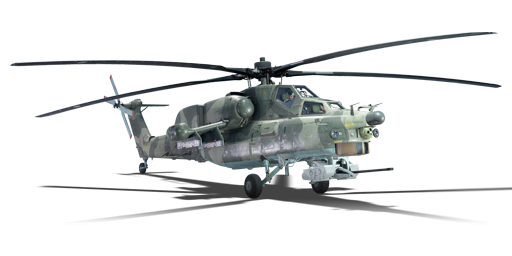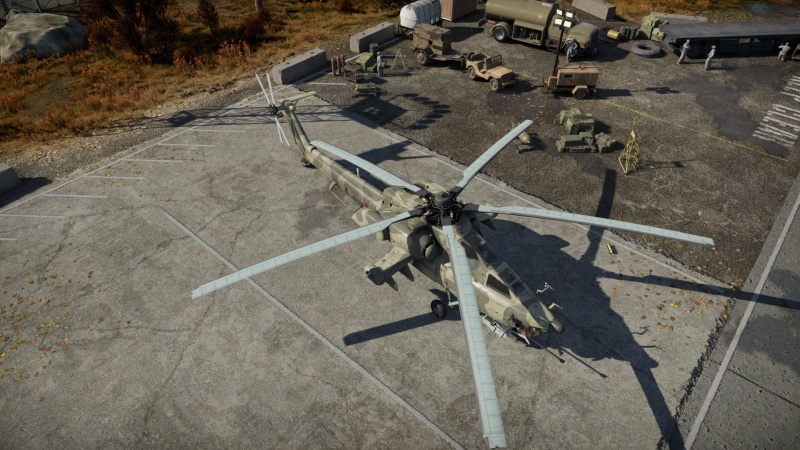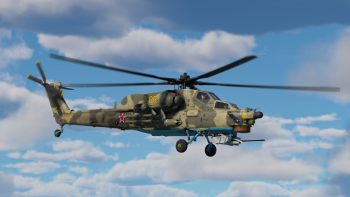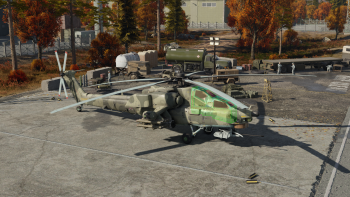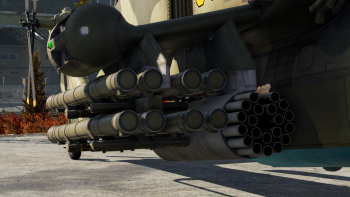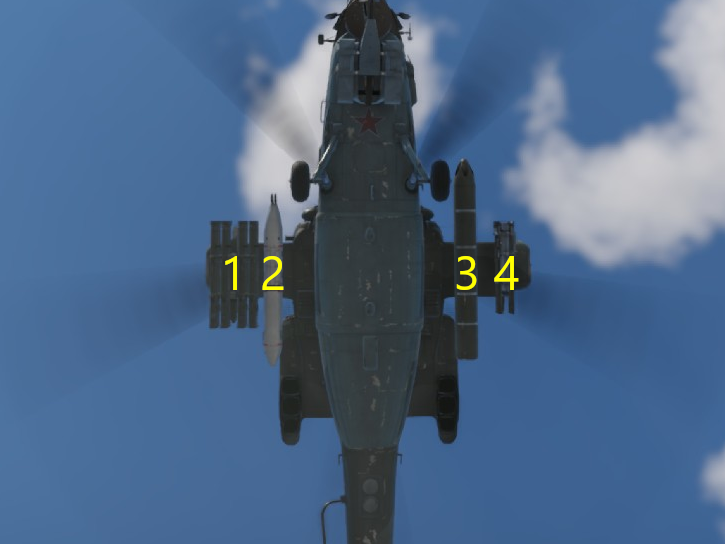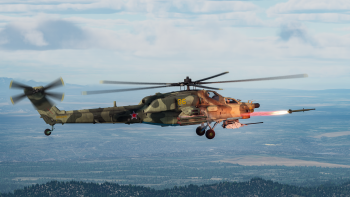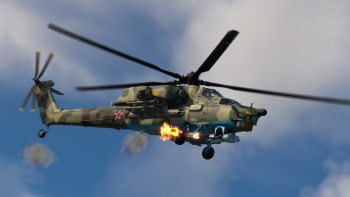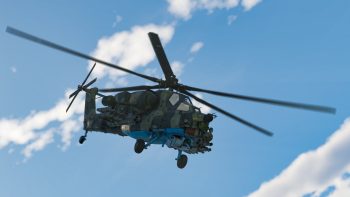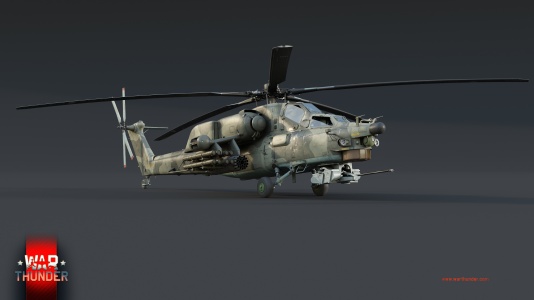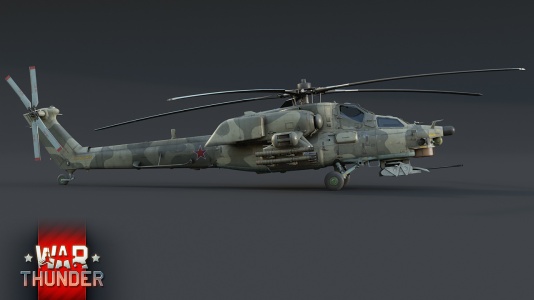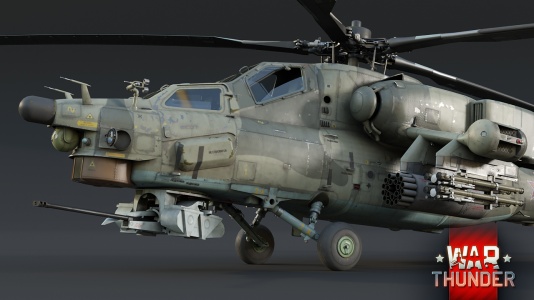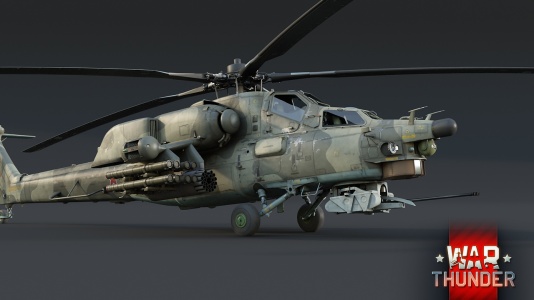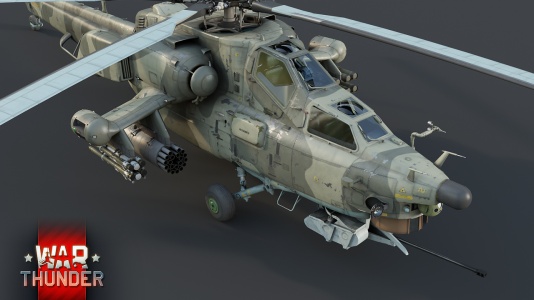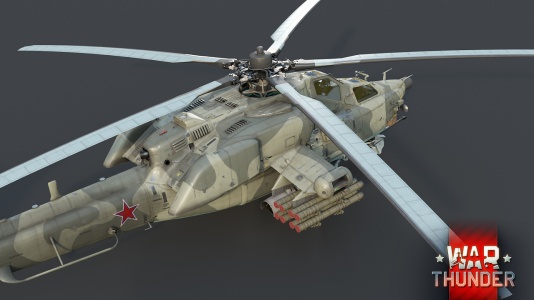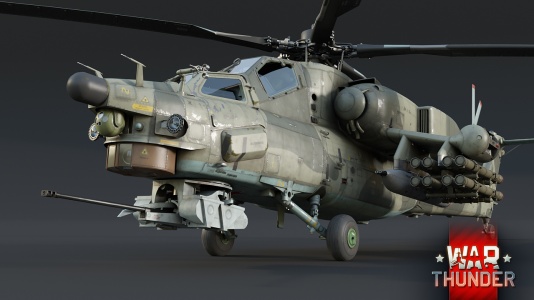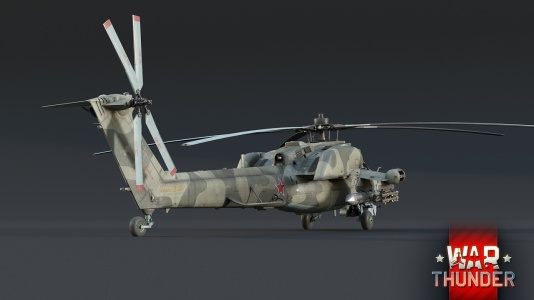Mi-28N
| This page is about the Soviet attack helicopter Mi-28N. For other versions, see Mi-28 (Family). |
Contents
Description
The Mi-28N is a rank VII Soviet attack helicopter with a battle rating of 10.7 (AB/SB) and 11.0 (RB). It was introduced in Update 1.93 "Shark Attack".
General info
Flight performance
| Characteristics | Max Speed (km/h at 1,000 m) |
Max altitude (metres) | |
|---|---|---|---|
| AB | RB | ||
| Stock | 273 | 256 | 5400 |
| Upgraded | 324 | 300 | |
Survivability and armour
- Armour plates
- 42 mm Bulletproof glass (52°) - Frontal windshield
- 22 mm Bulletproof glass - Side windows
- 10 mm Aluminium alloy - Cockpit front, middle, rear and bottom
- 10 mm Aluminium alloy - Cockpit sides and doors
- 16 mm Ceramic - Cockpit sides
- 8 mm Steel - Canopy framing
The gunner and the pilot are protected frontally and laterally by bulletproof glass. The front, rear, lower side and bottom of the cockpit are protected by aluminium alloy plates and there is an additional protection plate between the pilot and the gunner. The lower sides of the cockpit are protected by aluminum alloy superposed to ceramic while the canopy cockpit is protected by steel and bulletproof glass.
Modifications and economy
Armaments
| Ballistic Computer | ||
|---|---|---|
| CCIP (Guns) | CCIP (Rockets) | CCIP (Bombs) |
| |
|
|
Offensive armament
The Mi-28N is armed with:
- A choice between two presets:
- 1 x 30 mm 2A42 cannon, chin turret (250 rpg)
- 1 x 30 mm 2A42 cannon, chin turret (250 rpg) + 128 x countermeasures
Suspended armament
The Mi-28N can be outfitted with the following ordnance presets:
- Without load
- 8 x 9M39 Igla missiles
- 80 x S-8KO rockets
- 20 x S-13OF rockets
- 4 x 9M120 Ataka missiles
- 8 x 9M120 Ataka missiles
- 16 x 9M120 Ataka missiles
- 2 x 23 mm GSh-23L cannons (250 rpg = 500 total)
Custom loadout options
| 1 | 2 | 3 | 4 | ||
|---|---|---|---|---|---|
| 23 mm GSh-23L cannons (250 rpg) | 1 | 1 | |||
| S-8KO rockets | 20 | 20 | 20 | 20 | |
| S-13OF rockets | 5 | 5 | 5 | 5 | |
| 9M39 Igla missiles | 4 | 4 | |||
| 9M120 Ataka missiles | 4, 8 | 4, 8 | |||
| Maximum permissible weight imbalance: 480 kg | |||||
Usage in battles
Ground RB
The Mi-28N is a fast, heavily armed and armoured, but not very manoeuvrable helicopter. For many, the Havoc is the perfect helicopter for utter destruction, given it can mount a total of sixteen Ataka ATGMs as well as liquid explosives as just some icing on the cake. Combined with the 2A42 autocannon equipped with APDS rounds penetrating 82 mm of armour, high-resolution thermals and decent survivability, the Havoc is great for all missions. It's a great first-spawner; 8 Igla AAMs are very useful, especially at the start of matches. They've got great flare resistance, and while they may not pull as much as a Mistral, they can still be great for shooting down dangerous enemies like A-10s and other jets that have just spawned in the air.
With ATGMs
At a comfortable range, 16 Atakas is more than enough ATGMs to deal with any and all threats that your team faces. It's suggested to go for priority targets first, the targets that your team is struggling to eliminate, like an enemy tank in a hull-down position, or for you, any SPAAs that may be in the area. This will be very useful for your team. If you run out of Atakas, it is advised to return to base and rearm for a second run.
It's advised to watch for SPAAs first before you get down to business. At this battle rating, SAMs are incredibly deadly. Once one fires on you, you've run out of options if you're unable to terrain mask. Their missiles can reach you in seconds from kilometres away, so always be sure you are clear of enemy air defence before engaging the rest of the enemy team. If at low altitude, you could play whack-a-mole with the enemy SPAA, in hopes to drain their ammunition reserves, though letting your team get to them first is a better strategy.
Atakas can double as an AA platform as well. Unlike the Hellfires seen on many Western helicopters, the Atakas don't go straight up, as they are beam-riding ATGMs. This means you can lock an enemy aircraft, of course under the Ataka's maximum range of 6 km, fire, and watch it go to the target. If the target is manoeuvering, be sure to hit your sight stabilization (lock) key again so that you can give some control to the missile while it's locked on to the enemy. Not doing this could lead to the Ataka missing. As the Atakas don't feature a proximity fuse like the Vikhr missiles, a direct hit is required.
With rockets + AAM
The Havoc's first spawn loadout is an effective combination of rockets and air-to-air missiles. The gun alone is enough to destroy many targets. The rockets are great for disabling enemy tanks at range, and destroying them when up close. The Iglas, while not the best AAMs, are able to be mounted in racks of four - two on each side - making a grand total of eight air-to-air missiles. This gives you a lot of opportunity to engage enemy air units, especially helicopters; whether they spawn in first or they come into the game later with ATGMs: if you happen to survive to the mid-game, you can be an essential air defence platform for your team.
It's recommended to climb directly above the battlefield if there are no enemy SPAAs. If there are, stick to the lower ground and let them be destroyed later on in the match; it's not worth it to poke out and attempt to duel it, especially if it knows your exact location. Rushing in and hoping to see a group of enemies is not the best strategy; your chopper will be easily shot down this way. Knowledge is power. Above the battlefield, and with the thermal imaging, you can essentially scout every enemy for your team by shooting a couple of rounds.
Once clear, a good strategy is to begin hammering tanks with the 30 mm autocannon. These can stop them right in the tracks and critically damage components, which could allow your team to secure a capture point, destroy a few tanks you've damaged, and just turn the tide in favour of your team in general. It's a great way to rack up kill assists, which not only help you, but your team as well. However, there is one thing to consider, and that's ammunition. You have 250 rounds; and a better strategy than holding down the trigger is just to tap fire. You'll be more accurate this way; in some cases you'll find yourself sniping out enemy transmissions and engines from large distances by tapping. This not only conserves ammunition, but provides maximum efficiency by negating as many missed shots as possible.
You can also plot the perfect route for you to engage targets. Since you can see a large portion of the enemy team, a good tactic is to pick out an area with the least amount of enemy tanks. The route maximizes survivability, and once those targets are destroyed, and if there is a capture point nearby, it could be yours for the taking. This works best on long range maps or matches without a lot of players.
It's advised to be quite careful at low altitudes with the Havoc. It's not the most manoeuvrable thing in the world; it takes one wrong manoeuvre and the chopper is destroyed. The Mi-28N is particularly lacking in the pitch speed. This makes it great for long turns around corners, but quick manoeuvres can be quite a challenge. Landing quickly can prove to be difficult as well; it's advised to use the hover key to avoid a vortex ring if you do plan on making quick landings.
Oftentimes you'll note that enemies you've killed will spawn an SPAA to remove you in an instant, so it is greatly recommended to get some distance between you and the enemies after you destroy a few. The Havoc can get out fast thanks to its high top speed and acceleration, but be careful not to overspeed and compress into the ground from a dive.
Arcade Ground Assault
The best loadout to take in Arcade Ground Assault is the 16 Atakas and the S-13OFs, or the 16 Atakas and 40 S-8KOs, if you're a sharpshooter. 16 Atakas is a more fitting number for this mode, and you can destroy the enemy planes that come in at the start, and the pesky SPAA that spawn later a few rounds in. The turret works wonders in this mode too! Use it to destroy transmissions and engines to stop the enemy tanks from approaching the base too quickly.
The S-13OFs can basically guarantee kills as they're so powerful. However, you have 10 shots, then you must return to rearm. Paired with 16 Atakas along with the cannon and you have a deadly loadout.
The S-8KOs can serve the same purpose as the gun; immobilize enemy tanks that are closing in on the base. However, you have 40 of these to shoot out. This means you have a lot of room to miss a couple of rockets.
Pros and cons
Pros:
- Amazing speed
- Very effective anti-tank capabilities
- Can carry 8 Iglas for air-to-air capabilities
- Wide array of countermeasures: 128 flares, MAW, and a 360 degree RWR
- Very effective and punchy cannon
- High-resolution thermal imaging
Cons:
- Heavy helicopter; this impacts its manoeuvrability
- Only 250 rounds for the main gun, fire sparingly
- Igla AAMs can pull only 10Gs, engaging jet fighters can sometimes be a challenge
- Large target
History
Following the introduction into service of the Mil Mi-24 Hind, design work began on an optimised attack helicopter with reduced secondary transport capacities, intended for a primary anti-armour and anti-helicopter role as well as providing aerial cover for helicopter landings. Following a number of proposed concepts, a preliminary design was chosen in 1977. Following the construction of a mock-up, a prototype was constructed and first flew on November 10th 1982, with a second prototype completed in 1983. Trials of the Mi-28 began in 1984, but the type lost out to the Kamov Ka-50. Despite this, lower priority development of the Mi-28 continued and production of the Mi-28 was approved in December of 1987. In January of 1988, the first prototype Mi-28A flew, fitted with more powerful engines and a different tail rotor; this prototype was first shown to the Western world at the 1989 Paris Air Show. In 1991, a second prototype of the Mi-28A flew, but with the end of the Cold War, the end of the Soviet Union, and ensuing cuts in the defence budget, the Mi-28A was re-evaluated and found superior to the Ka-50, especially due to it lacking all-weather capabilities. As such, the Ka-50A was cancelled in 1993.
The Mi-28N was first presented in 1995, and first flew on November 14th, 1996. Unlike the preceding Mi-28A, the Mi-28N was fitted with a whole array of vision aids, such as a radar, a gun camera, and a forward-looking infrared (FLIR) sight, giving it all-weather capability. Once again, the post-Cold War realities in the Russian Federation meant that funds were not available and the program was given a low priority.
This changed in 2000, when attention was given to re-equipping the Russian Army. The Mi-28N was given a new priority, as a future replacement of the Mi-24. In 2004, a second prototype with an altered main rotor design was flown and, after trials, the first production Mi-28N was accepted by the Russian military on June 5th 2006, with the type being declared operational in October 2009. An export model, the Mi-28NE, has since been sold to both Iraq and Algeria. An updated model, the Mi-28NM, was first flown in 2016, with the first production examples delivered to the Russian military in June 2019.
Media
- Skins
- Images
- Videos
See also
Links to the articles on the War Thunder Wiki that you think will be useful for the reader, for example:
- reference to the series of the helicopter;
- links to approximate analogues of other nations and research trees.
External links
| Mil Moscow Helicopter Plant | |
|---|---|
| Attack | Mi-4AV |
| Mi-8AMTSh · Mi-8TV | |
| Mi-24A · Mi-24P · Mi-24V | |
| Mi-28N · Mi-28NM | |
| Mi-35M | |
| Export | ◊Mi-8TB |
| ▂Mi-24D · ◔Mi-24D · ◔Mi-24V · ◔Mi-24P · ◊Mi-24P · ◄Mi-24P HFS 80 | |
| Mi-28A | |
| USSR helicopters | |
|---|---|
| Attack | |
| Hound | Mi-4AV |
| Hip | Mi-8AMTSh · Mi-8TV |
| Hind | Mi-24A · ▂Mi-24D · Mi-24P · Mi-24V · Mi-35M |
| Havoc | Mi-28N · Mi-28NM |
| Helix | Ka-29 |
| Hokum | Ka-50 · Ka-52 |


